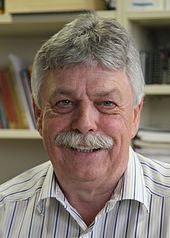Bruno Karl Meyer
Bruno Karl Meyer (born July 5, 1949 in Haibach ; † December 2, 2014 in Gießen ) was a German physicist who worked as a university professor and institute director, primarily in the fields of solid-state physics and electric space propulsion .
Career
Meyer studied physics at the Johann Wolfgang Goethe University in Frankfurt am Main and did his doctorate in radiation biophysics with Wolfgang Pohlit. He then moved to the University of Paderborn , where he did his doctorate in the field of hydrogen centers in alkali halides in the group of Johann-Martin Spaeth. He wrote his habilitation thesis in the field of intrinsic defects in II-VI semiconductors . He kept this research direction during his time as C3 professor at the Technical University of Munich , whereby his research interests expanded increasingly from defect physics to the properties of electronic transport. As part of theDFG Priority Program "II-VI Semiconductors" he published fundamental work on the nitrogen center in zinc selenide and its p-conductivity . He was one of the first in Germany to recognize the importance of Group III nitrides for optoelectronics . Subsequently he was co-initiator of the DFG priority program "Group III Nitrides and their Heterostructures ".
In 1996 Meyer received a call to the "X-ray chair" at the I. Physics Institute of the Justus Liebig University in Giessen , which he headed as director until his death. One focus of his research activities here were thin-film processes for the production of oxidic materials for photovoltaic and thermochromic applications. His scientific work was shaped by the search for application-relevant materials. In the 1990s he became a pioneer for gallium nitride , after the turn of the millennium with zinc oxide and in recent years in the search for "green" oxides such as copper oxides or tin oxides .
In addition, Meyer devoted himself to the development of ion beam engines for space travel, thus continuing a research direction founded by Horst Löb in the 1960s. With the acquisition of a LOEWE focus under Meyer's direction, the basis was laid for, among other things, intensive cooperation with DLR and the introduction of a focus on "atomic, plasma and space physics " in the master’s course in physics .
| personal data | |
|---|---|
| SURNAME | Meyer, Bruno Karl |
| BRIEF DESCRIPTION | German physicist |
| DATE OF BIRTH | July 5, 1949 |
| PLACE OF BIRTH | Haibach |
| DATE OF DEATH | 2nd December 2014 |
| Place of death | to water |
